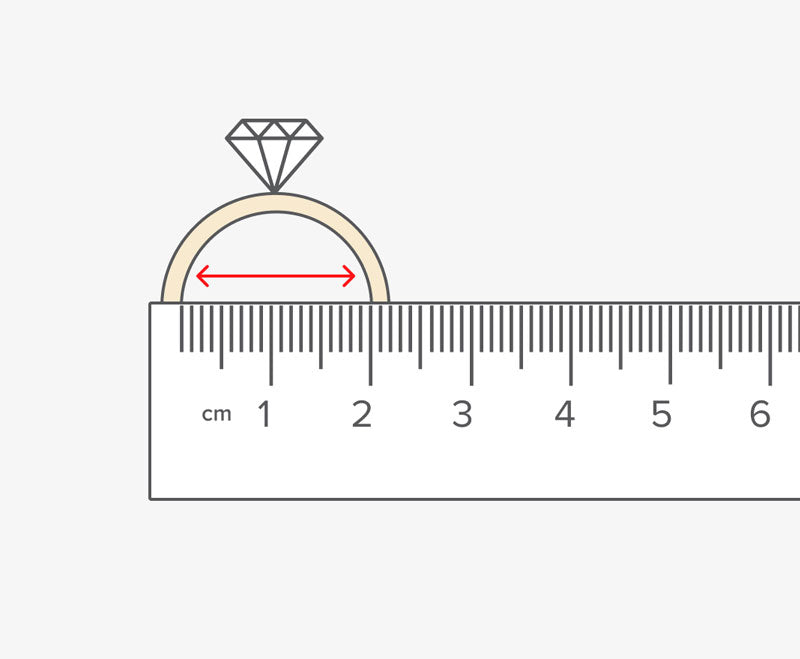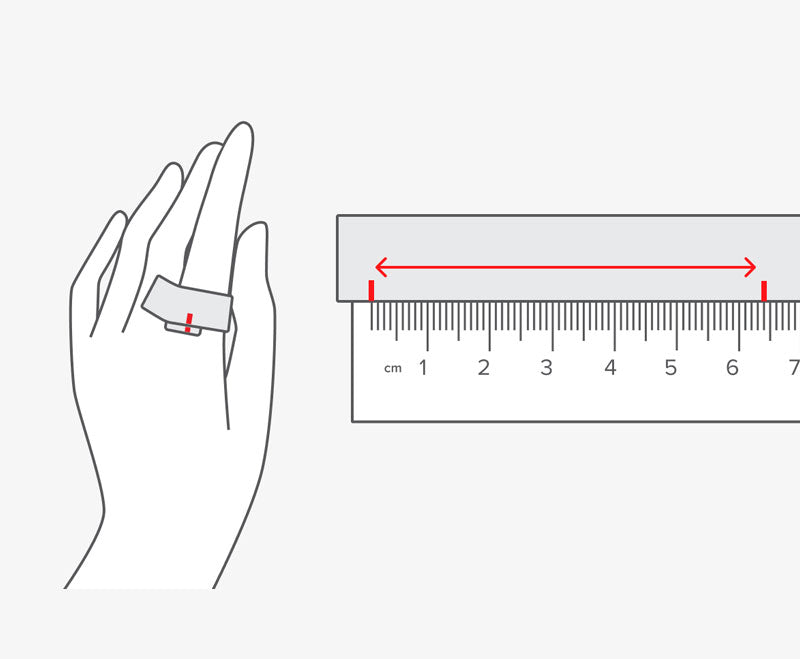Ring Size Chart & Guide
Here are two simple ways to find your perfect ring size. If you have a ring that fits well, you can either measure it directly or compare it with our printable ring size guide. If you don't have a ring, you can measure your finger to find the right size. Learn how to measure your ring size below.

Method 1: Measure existing ring
- Find a ring that fits well on the finger where you intend to wear your new ring.
- Use a ruler or measuring tape to measure the inside diameter of the ring.
Make sure the ruler shows millimeters (mm), then place your ring on top
of the ruler and measure the part that touches your finger. - Use our Ring Size Chart to find the right ring size based on your measurement.

Method 2: Measure with paper
- Cut a piece of paper about 10 centimeters (cm) long.
- Wrap the paper or string around your finger where the ring will go. Make sure it fits comfortably, not too tight or too loose.
- Use a pen to mark where the end of the string or paper meets itself.
- Lay the string or paper flat against a ruler or tape measure, and measure the length (in mm) from the end to the mark you made.
- This length is your finger's circumference. You can use it to find your ring size with our Ring Size Chart below.
Ring Size Chart
Measure the circumference (or diameter) of your finger in millimeters and find your associated US ring size in the chart below.
| RING SIZE (US) | RING SIZE (UK/AUS) | INTERNAL DIAMETER (MM) | CIRCUMFERENCE (MM) |
|---|---|---|---|
| 6 | L | 16.5 | 51.8 |
| 7 | N | 17.3 | 54.3 |
| 8 | P | 18.1 | 57 |
| 9 | R | 19 | 59.5 |
| 10 | T | 19.8 | 62.2 |
| 10.5 | U | 20.2 | 63.5 |
| 11 | V | 20.6 | 64.7 |
| 12 | X | 21.4 | 67.2 |
| 13 | Z | 22.2 | 69.7 |
| 14 | Z | 23 | 72.3 |
Ring Size Measurement FAQs
You can measure your ring size at home using two methods:
Method 1: Use an existing ring that fits you well. Measure the inside diameter of the ring with a ruler in millimeters (mm) and compare it with our Ring Size Chart.
Method 2: Wrap a piece of paper or string around your finger, mark the point where it overlaps, and measure the length in millimeters. Use this measurement to find your ring size using the Ring Size Chart.
If you don't have a ring to measure, you can still find your ring size by measuring the circumference of your finger. Use a piece of paper or string to wrap around the finger where you'll wear the ring, mark the point where the ends meet, and measure the length in millimeters. You can also visit a jeweler, who can help you determine your ring size with professional tools.
The most accurate way is to measure the internal diameter of a ring that fits you well using a ruler with millimeter markings. For best results, ensure the ring is round and not misshapen. Alternatively, you can visit a jeweler, who can professionally measure your ring size to ensure precise accuracy.
Yes, you can use a string or a piece of paper to measure your finger. Just wrap it around your finger where the ring will sit, mark the point where the string overlaps, and measure the length in millimeters to find your ring size.
Your measurement is correct if the ring fits comfortably—neither too tight nor too loose. It should slide over your knuckle with a little resistance and sit snugly on your finger.
The diameter of a ring is the distance across the inside of the ring, measured straight through the center. It's the internal width of the ring and is typically measured in millimeters. On the other hand, the circumference is the total distance around the inside of the ring. Think of it as the length of the inside edge if you could lay it out flat. Both measurements can be used to determine your ring size, but they refer to different aspects of the ring's shape.
For example, if the internal diameter of your ring is 16 mm, the circumference would be approximately 50.3 mm. Both measurements are useful for determining your ring size, but they refer to different aspects of the ring's shape.
If your measurement falls between two sizes, it's usually best to choose the larger size to ensure comfort, especially if the ring has a wider band.
Yes, your fingers can swell slightly throughout the day due to various factors like temperature and activity level. It's best to measure your finger size at the end of the day when your fingers are likely at their largest.
Yes, our Ring Size Chart includes conversions for US sizes to UK/AUS sizes, along with corresponding internal diameters and circumferences in millimeters.
It's normal for ring size to change slightly over time due to factors like weight fluctuation or aging. If you're unsure of your current size, it's a good idea to re-measure before purchasing a new ring.
To ensure a perfect fit, double-check your measurements using both methods if possible and consult the Ring Size Chart. If you're between sizes, opt for the larger size, and consider the width of the ring band, as wider bands may require a slightly larger size. For the best results, you can also visit a jeweler, who can measure your finger accurately to help ensure the ring will fit perfectly.
Need More Help?
If you're still unsure about your ring size or have additional questions, feel free to reach out to us here. We're here to assist you!
